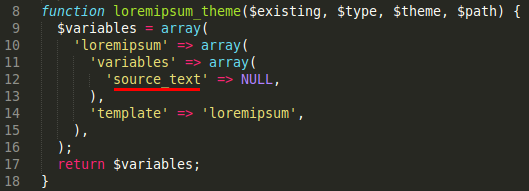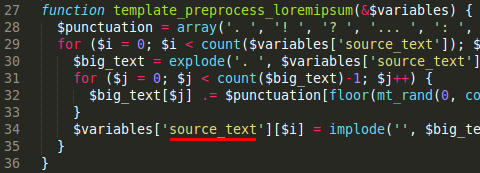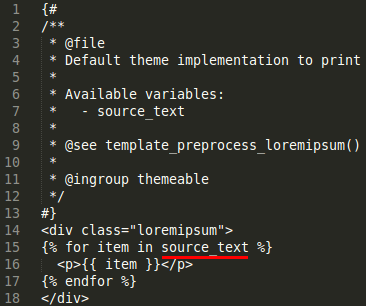Aggiungere un template di tematizzazione in un modulo Drupal
Parte III della guida pratica alla creazione di moduli di base in Drupal 8
Dai file .info ai test, solo le basi
loremipsum.module
/**
* Implements hook_theme().
*/
function loremipsum_theme($existing, $type, $theme, $path) {
$variables = array(
'loremipsum' => array(
'variables' => array(
'source_text' => NULL,
),
'template' => 'loremipsum',
),
);
return $variables;
}
Un altro motivo per non abbandonare il file .module è che è proprio lì che va hook_theme(). Funziona quasi allo stesso modo di D7: dichiari un array che contiene le tue variabili e il file di template, che deve essere salvato nella posizione corretta (cartella templates) con estensione .html.twig.
Poi, prima di passare l’array di rendering a Twig, puoi eseguire un po’ di preprocess. Il seguente hook inserisce una punteggiatura casuale alla fine di ogni frase:
/**
* Template preprocess function for Lorem ipsum.
*
* @param array $variables
* An associative array containing:
* - source_text
*/
function template_preprocess_loremipsum(&$variables) {
$punctuation = array('. ', '! ', '? ', '... ', ': ', '; ');
for ($i = 0; $i < count($variables['source_text']); $i++) {
$big_text = explode('. ', $variables['source_text'][$i]);
for ($j = 0; $j < count($big_text) - 1; $j++) {
$big_text[$j] .= $punctuation[floor(mt_rand(0, count($punctuation) - 1))];
}
$variables['source_text'][$i] = implode('', $big_text);
}
}
/templates/loremipsum.html.twig
{#
/**
* @file
* Default theme implementation to print Lorem ipsum text.
*
* Available variables:
* - source_text
*
* @see template_preprocess_loremipsum()
*
* @ingroup themeable
*/
#}
<div class="loremipsum">
{% for item in source_text %}
<p>{{ item }}</p>
{% endfor %}
</div>
Ora l’array $source_text viene elaborato con un semplice ciclo for dentro il nostro Twig, racchiuso da tag <p>.
Nota la corrispondenza tra hook_theme(), template_preprocess_hook() e il nostro file Twig:


